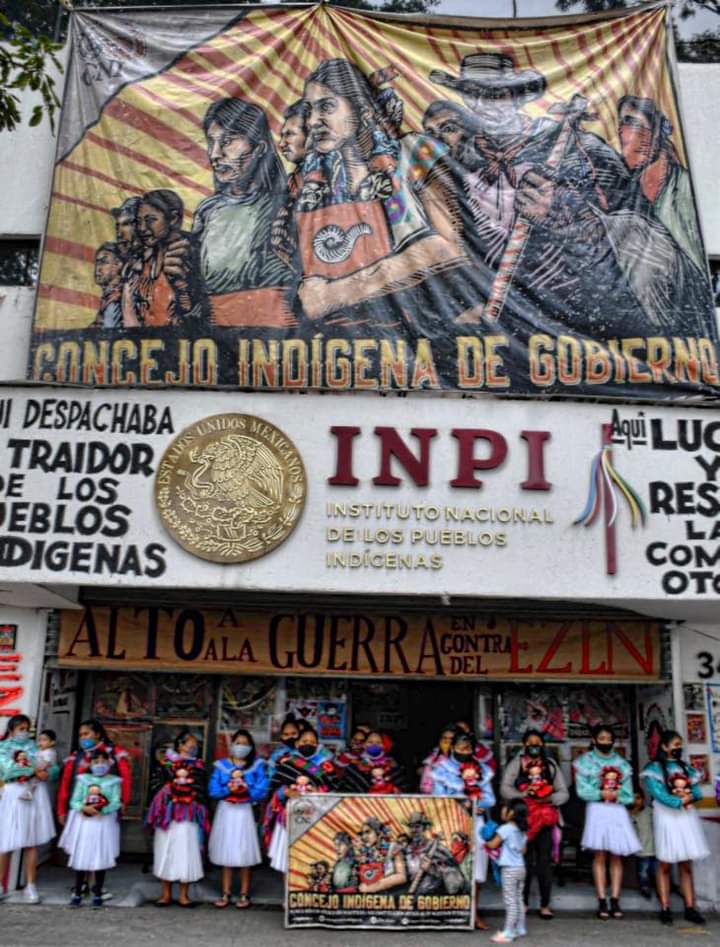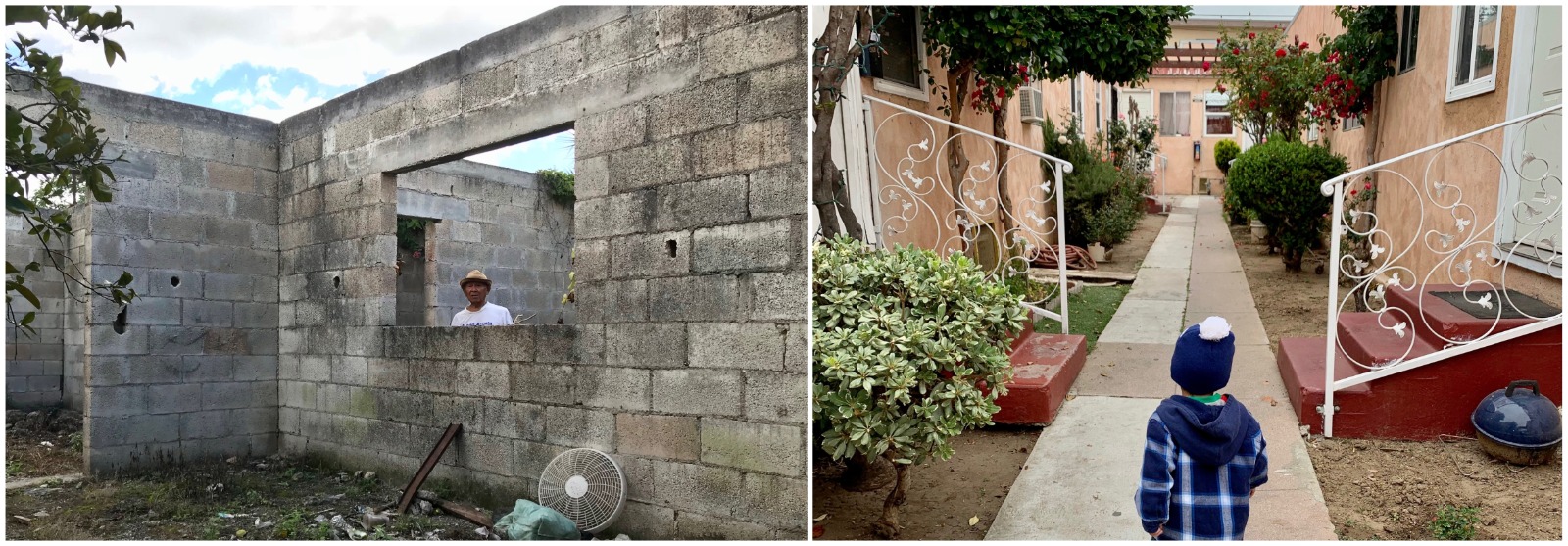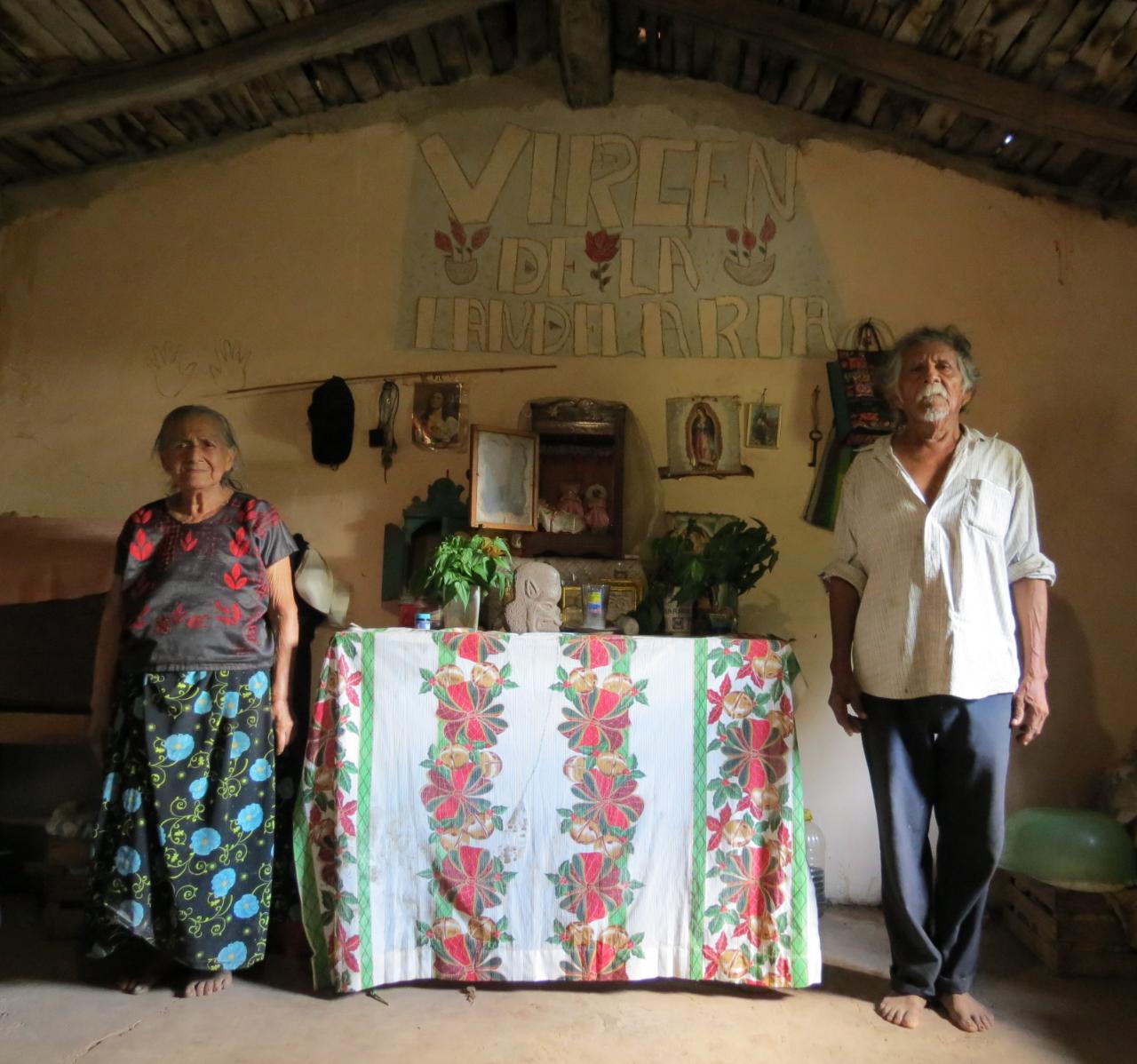Foto 1. Mi abuelo en la casa que mi tío no terminó de construir | Foto 2. El bisnieto de mi abuelo en nuestro vecindario en L.A.
Por Génesis Ek
Casa. ¿Qué es una casa? ¿Qué significa tener un hogar como migrante? En muchos casos, por la migración, las personas se mudan a un nuevo país y se construyen ahí un nuevo hogar. Sin embargo, éste no es el caso de muchas comunidades indígenas, especialmente la nuestra. En nuestro caso, la mayoría alquila un espacio para vivir al mismo tiempo que envía dinero a su comunidad de origen para construir allá sus casas. Siempre sigue viva la idea de que algún día volverán a esa casa, que estará lista y que finalmente podrán reunirse con sus familias, con su gente y con su pueblo; por eso es que mandan un poco de dinero en cada oportunidad, su objetivo es terminar de construir, por fin, una casa.
Ésta ha sido la historia de mi familia desde que sus integrantes emigraron a los Estados Unidos hace treinta años. La migración comenzó con mi tío, quien luego convenció a mis otros tíos de migrar también, para que pudieran brindar estabilidad económica a sus familias. Mis tíos dejaron a sus esposas e hijos en Yucatán. La idea que tenían era trabajar lo más posible hasta lograr construir una casa en el terreno que mi abuelo les tenía destinado. El dinero de cada cheque que recibían como pago por su trabajo era enviado en su mayor parte a su comunidad de origen. Pero esto duró sólo unos meses. Todos mis tíos extrañaban a sus familias, así que mandaron por ellas, trajeron a sus esposas e hijos y también trajeron a mi mamá. Sin embargo, esto no impidió que siguieran enviando dinero al pueblo para continuar con la construcción de sus casas; seguían pensando en terminar de edificar sus hogares para que, una vez ganada cierta estabilidad económica, pudieran, simplemente, regresar.
Como todavía soñaban con volver al pueblo (y ese sueño era el que podían pagar enviando dinero al país de origen), alquilaron departamentos con un solo dormitorio en la misma calle, en diferentes edificios, pero unos cerca de los otros. Así comenzamos a echar raíces en un vecindario llamado East Hollywood, uno de los muchos vecindarios en donde vivía la clase trabajadora y que era considerado peligroso y poco atractivo porque ahí vivíamos los migrantes. Se trataba de uno de los pocos vecindarios en donde mi familia podía permitirse vivir, además estaba cerca del centro de la ciudad, cerca de Hollywood y de Griffith Park, lugares en donde era más fácil hallar trabajo. En una misma calle, dentro de East Hollywood, fuimos construyendo una comunidad articulada con otras comunidades de migrantes que en ese tiempo eran mayoritariamente centroamericanas. Como es costumbre en el pueblo, mi familia compartió su comida, su idioma y su cultura con nuestros vecinos. Creamos nuestro propio “pueblito”.
Con el paso del tiempo, los migrantes fueron enviando cada vez menos dinero a su pueblo de origen. El costo de vivir en Los Angeles se fue incrementando; a pesar de que el alquiler estaba controlado, la renta fue subiendo mientras los salarios se mantuvieron iguales. Esto tuvo como consecuencia que, finalmente, dejaran de enviar dinero para la construcción de sus casas en México. Se instalaron en diminutos departamentos con la esperanza de poder volver a enviar dinero algún día y así terminar la edificación de sus casas.
Han pasado los años y los migrantes llegaron a amar este vecindario en Los Angeles casi tanto como amaban su comunidad de origen. Sin embargo, justo cuando comenzaban a echar raíces profundas aquí, justo cuando comenzaban a renunciar a sus sueños de volver, los alcanzó un proceso de gentrificación. Personas que antes no se interesaban en nuestro vecindario comenzaron a hacerlo; tenían más recursos económicos que nosotros y fueron mudándose mientras que nuestros antiguos vecinos comenzaron a irse a otros lugares. El precio del alquiler comenzó a aumentar poco a poco y la gente ya no podía permitirse vivir en este vecindario. Después, los desarrolladores urbanos comenzaron también a interesarse pues nuestro vecindario tenía una muy buena ubicación: una estación de tren que lleva directamente al centro de Los Angeles y a lugares turísticos como Hollywood y Universal City. Uno de los propietarios vendió uno de los edificios de nuestra calle a una empresa e inmediatamente esta compañía comenzó a remodelar las viviendas disponibles e intentó expulsar a los residentes del resto del edificio. Este asunto llegó a los tribunales y los antiguos residentes se vieron obligados a aceptar una compensación económica para mudarse fuera de ahí. En un principio pensamos que se trataba de un caso aislado pero nos equivocamos, meses después compraron otro edificio al otro lado de la calle.
Al principio mi familia tuvo suerte, los edificios en los que vivíamos permanecieron a salvo hasta hace 8 años cuando el edificio en el que vivía mi tío fue vendido. Los compradores ofrecieron algo de dinero a los residentes, muchos de ellos aceptaron la oferta y se mudaron a otros lugares. Mi tío se negó a dejar su vivienda. Ya había invertido mucho tiempo, esfuerzo y dinero en su departamento. Sabía que nunca sería de su propiedad pero pensaba que si estaba pagando el alquiler y se aseguraba de arreglar el departamento, todo estaría bien. Él sabía que no estaba solo en esta lucha así que se negó a aceptar la oferta económica para irse. Con el paso del tiempo, la empresa que había comprado el edificio fue creando un ambiente que hacía muy complicado vivir ahí. Comenzaron imponiendo reglas para los espacios comunes, ya no podían colocar ahí bancos de uso común para sentarse ni estaban ya permitidos los carritos que compartían los vecinos hasta hace poco. La empresa fue haciendo la situación cada vez más insostenible hasta que les dijo a los residentes que iban a tener que mudarse pues comenzarían un proceso de “remodelación” de todo el edificio para adecuarlo a un nuevo “código”. Mientras tanto, los dueños se comprometían a proporcionarles una nueva vivienda pero los ubicarían en otro edificio; si después deseaban regresar después a sus departamentos tendrían que pagar más del doble de renta porque el control de alquileres ya no se podría aplicar de ahí en adelante. Mi tío nunca había vivido a más de diez minutos de las viviendas de sus hermanos, no podía imaginar estar lejos de ellos pues cada uno de ellos representaba un ancla para los demás; así que comenzó a buscar departamentos cercanos y, por fortuna, pudo encontrar una opción a la vuelta de la esquina. Terminó por aceptar la oferta de mudarse a un nuevo lugar y, con alivio, pudo al menos permanecer dentro del área.
Este alivio duró poco, el edificio al que mi tío se fue a vivir ha sido vendido también y él está volviendo a vivir la misma pesadilla. El más afortunado fue mi otro tío. Él también se negó a mudarse y, por fortuna, la empresa que compró el edificio se dio cuenta que era mucho trabajo expulsar a todos los inquilinos, así que simplemente arreglaron los departamentos que estaban vacíos y dejaron a los residentes permanecer ahí, pero esta situación no es lo común. Mi tío sabe que esta suerte puede durar solo un tiempo; sabe también que sus hermanos pueden ser presionados para mudarse lejos de él y eso lo pone nervioso.
Mi familia migró para huir de la precariedad laboral y los problemas en el acceso a una buena alimentación que había en su pueblo, ahora están en una ciudad que no puede asegurarles siquiera un techo. En estos días, han vuelto a pensar en que debieron haber continuado enviando dinero a sus comunidades de origen para terminar de construir sus casas ahí, sobre todo, sabiendo ahora que su futuro en los Estados Unidos sigue en la incertidumbre igual que lo estaba cuando vivían en su pueblo. Muchas de las casas que comenzaron a edificar en su comunidad permanecen a medio construir, están a la espera de ser terminadas, al igual que la lucha que están llevando aquí.
House
House. What is a house? What does it mean to have a home as a migrant? In many cases of migration, people move to a new country and build themselves a new home there. This isn’t the case for many indigenous communities, especially ours. Most rent a space to live and send money back home to build their houses. There is always this idea that one day, they will go back home and have their house ready, and they’ll finally be able to reunite with their families, their people, their town, so they send a little money over every opportunity they get to build their home.
This has been my family’s story since they migrated to the US 30 years ago. It started with my tio, who then convinced my other tios to migrate so they could provide their families economic stability. They left behind their wives and children in Yucatan. The idea was to work for as long as they could to build a house on the land my grandpa had for them. With every paycheck they got, they sent money home. This only lasted a few months. All my tios missed their families so they sent for them. They sent for their wives and children as well as for my mom. This didn’t stop them from sending money to the pueblo to keep on building their houses. They always thought they would just keep building and once they knew they had earned enough to be stable, they’d just go back.
Because they still had dreams of going back to the pueblo (and it was all they could afford), they each rented one-bedroom apartments on the same street in different buildings, but still next to each other. This was the beginning of setting roots in the neighborhood of East Hollywood. East Hollywood was one of the many working-class neighborhoods labeled as dangerous, and not appealing because it was full of immigrants. This was one of the few neighborhoods my family could afford to live in, but it was also close to downtown, Hollywood, and Griffith Park so it was easy to find a job nearby. On this street, they built a community with the other migrant communities (at the time it was mostly Central Americans). As is custom in the pueblo, my family shared their food, language, and culture with their neighbors. They created their own little “pueblito.”
As time went by, they would send less and less money to the pueblo. The cost of living in Los Angeles went up, rent (although there was rent control) kept going up while their wages remained the same. Eventually they stopped sending money for their houses all together. They settled in their tiny apartments and hoped to one day send money for their houses again.
Years have now gone by, and my family has grown to love this neighborhood almost as much as they love their pueblo. Just as everyone starts to settle down and give up on their dreams to go back, gentrification begins. There was a shift of who was interested in the neighborhood. It started when people from better economic backgrounds started to move in and our neighbors began to move out. Rent was slowly increasing, and people could no longer afford to live in the neighborhood. Then developers took an interest in the neighborhood because of the location- it had a train station that took you straight to Downtown LA and to the touristy places of Hollywood and Universal City. One of the landlords sold a building on the street to a company. The company then went ahead and started immediately fixing the units that were empty and attempted to kick out the current residents. They took it to court, the residents were forced to accept a payout, and move. We thought it was an isolated case, but we were wrong because less than a few months later, they bought a building across the street.
We were lucky since the buildings my family lived in remained untouched, that was until 8 years ago. The building my tio was living in was sold. They offered everyone some money and many of them took the offer and left. My tio refused to leave. He had already invested so much time, effort, and money into this apartment. He knew it was never going to be a property he would own but he thought that if he was paying his rent and making sure to fix the apartment, he would be okay. He wasn’t alone in this fight, and he knew it. He refused to accept the offer. As time went by, the company made it harder and harder to live in the building. They started by placing rules on the communal spaces. They weren’t allowed to have communal benches they had and carts they all shared. They eventually made it so difficult by telling the tenants that they were going to have to move out since they were going to “remodel” the entire building to “bring it up to code.” They would provide housing to the remaining tenants, but it was going to be in a different neighborhood at another building and when they return, they are to pay the new rent prices, which was going to be more than double because then rent control would no longer apply. My tio has never been more than 10 minutes away from his siblings, couldn’t imagine being away from them as they have been eachothers’ anchors. He began looking for apartments near-by and was able to find a unit around the corner, so he was still very close by. He then decided to take the offer and move into the new place, relieved that he was at least able to remain in the area.
This was short lived because now, the building he lives in was just sold and he is reliving the same nightmare again as the building has also been sold. My other tio, he was really the lucky one. He refused to move but the company who bought the building he lived in accepted that it was too much work to push everyone out, so they just fixed up the apartments they had available and left the others alone, but this is rare. He knows that his luck only can only last so long and knowing his siblings may have to move further away, has him feeling nervous.
My family migrated to get away from the job and food insecurities that existed in their towns only to arrive in a city that cannot secure the roof over their heads. They are now thinking back on how they should have continued to send money back to finish their houses, especially knowing that their futures in the US remain as insecure as their lives did in the pueblo. Many of their houses in the pueblo remain half built, waiting to be done, as is their struggle.
Retrato de la escritora: Octavio Velez




